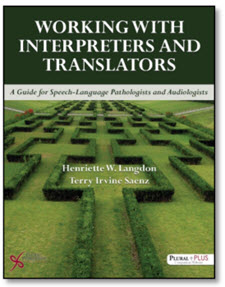 San Diego, CA – October 20, 2015 – Working with Interpreters and Translators: A Guide for Speech-Language Pathologists and Audiologists offers state of the art procedures to conduct appropriate interviews, assessments, and conferences with students with limited English language proficiency (ELL) and their families. The information presented is supported by a thorough review of the literature on best practices in interpreting for international conferences and legal and medical fields. Furthermore, the authors experience working with language interpreters and training professionals as well as graduate students in communicative disorders, makes this a very useful resource for professionals, interpreter/translators as well as undergraduate and graduate students enrolled in communicative disorder programs.
San Diego, CA – October 20, 2015 – Working with Interpreters and Translators: A Guide for Speech-Language Pathologists and Audiologists offers state of the art procedures to conduct appropriate interviews, assessments, and conferences with students with limited English language proficiency (ELL) and their families. The information presented is supported by a thorough review of the literature on best practices in interpreting for international conferences and legal and medical fields. Furthermore, the authors experience working with language interpreters and training professionals as well as graduate students in communicative disorders, makes this a very useful resource for professionals, interpreter/translators as well as undergraduate and graduate students enrolled in communicative disorder programs.
Federal and State Law specify that ELL students be assessed in their native language when referred for possible special education. The number of ELL students attending public schools across the nation has been increasing in the last few decades. There are not enough Speech Language Pathologists (SLPs) or audiologists who are proficient in the various languages spoken by ELL students even in Spanish, the most common language spoken by ELL students in the United States. The second best solution is to conduct fair assessments in collaboration with a trained interpreter/translator.
Key features include:
- Information and references to most common languages spoken by ELL students.
- A description of culturally based variables that need to be considered in the process of interviewing and working with linguistic and culturally diverse populations.
- A description of the roles and responsibilities of SLPs and audiologists as well as interpreters and translators who work together.
- A description of best practices in following speech-language and audiological assessments in the presence and absence of materials in a given language.
- Suggestions on training interpreters and translators as well as SLPs and audiologists in this collaborative process.
- Part Two is written for those individuals who will be collaborating as interpreters and translators with SLPs and audiologists in various contexts, such as interviews, assessments, and various meetings like IEPs and IFSPs.
Working with Interpreters and Translators: A Guide for Speech-Language Pathologists and Audiologists is a must have reference for everyone working with ELL students today. It should serve as a resource for professionals to ensure they are providing a fair evaluation to their clients to avoid under or over representation in special education. Although the process was developed with the pediatric population in mind, much of this information can be applied to older culturally and linguistic diverse populations who are in need of speech-language and/or hearing services. It should also be useful to professionals working with language interpreters in allied health professions in other countries as migration has been and is a common global phenomenon.
Book Details
Title: Working with Interpreters and Translators: A Guide for Speech-Language Pathologists and Audiologists | Editors: Henriette W. Langdon, EDD and Terry Irvine Saenz, PhD | Published: 10/15/2015 | ISBN: 978-1-59756-611-7 | https://pluralpublishing.com/publication_witgslpa.htm
About The Authors
Henriette W. Langdon, EdD is an ASHA certified speech-language pathologist, ASHA Fellow and Professor in Communicative Disorders and Sciences at San José State University in San Jose, CA. She has 40 years experience working with bilingual students who have a variety of speech, language, communication and learning challenges and has lectured locally, nationally and internationally on this topic.
Terry I. Saenz, PhD, is a professor of communicative disorders at California State University, Fullerton. She is the author of several journal articles on bilingual/multicultural speech-language pathology and coeditor with Dr. Henriette Langdon on Language Assessment and Intervention with Multicultural Students: A Guide for Speech-Language-Hearing Professionals.
About Plural Publishing, Inc.
Plural Publishing produces leading academic, scientific and clinical publications in the fields of speech-language pathology, audiology, otolaryngology, and professional singing. Plural Publishing, Inc. aims to fill a space in the field of communication sciences and disorders with high-quality publications written by world-class experts in order to improve and enhance the knowledge base of each profession, from the classroom to clinical practice. Plural Publishing prioritizes the intellectual growth of the disciplines it serves and strives to improve and advance these fields through its publications.

